Input interpretation

1-chloropropane
Chemical names and formulas
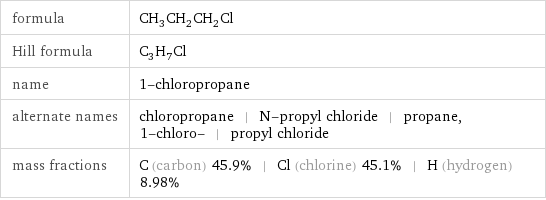
formula | CH_3CH_2CH_2Cl Hill formula | C_3H_7Cl name | 1-chloropropane alternate names | chloropropane | N-propyl chloride | propane, 1-chloro- | propyl chloride mass fractions | C (carbon) 45.9% | Cl (chlorine) 45.1% | H (hydrogen) 8.98%
Lewis structure
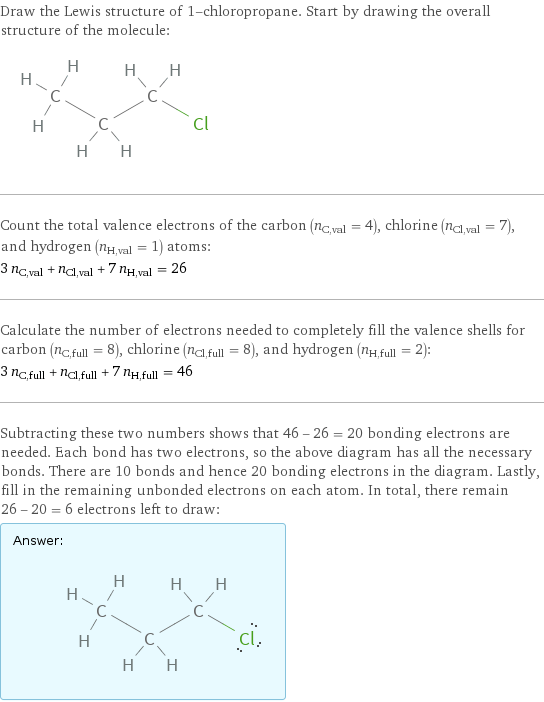
Draw the Lewis structure of 1-chloropropane. Start by drawing the overall structure of the molecule: Count the total valence electrons of the carbon (n_C, val = 4), chlorine (n_Cl, val = 7), and hydrogen (n_H, val = 1) atoms: 3 n_C, val + n_Cl, val + 7 n_H, val = 26 Calculate the number of electrons needed to completely fill the valence shells for carbon (n_C, full = 8), chlorine (n_Cl, full = 8), and hydrogen (n_H, full = 2): 3 n_C, full + n_Cl, full + 7 n_H, full = 46 Subtracting these two numbers shows that 46 - 26 = 20 bonding electrons are needed. Each bond has two electrons, so the above diagram has all the necessary bonds. There are 10 bonds and hence 20 bonding electrons in the diagram. Lastly, fill in the remaining unbonded electrons on each atom. In total, there remain 26 - 20 = 6 electrons left to draw: Answer: | |
3D structure
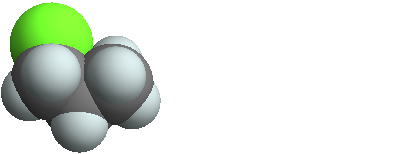
3D structure
Basic properties
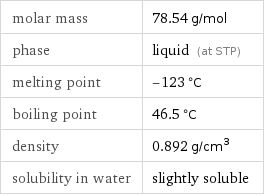
molar mass | 78.54 g/mol phase | liquid (at STP) melting point | -123 °C boiling point | 46.5 °C density | 0.892 g/cm^3 solubility in water | slightly soluble
Units

Liquid properties (at STP)
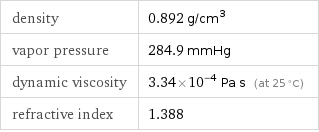
density | 0.892 g/cm^3 vapor pressure | 284.9 mmHg dynamic viscosity | 3.34×10^-4 Pa s (at 25 °C) refractive index | 1.388
Units

Thermodynamic properties
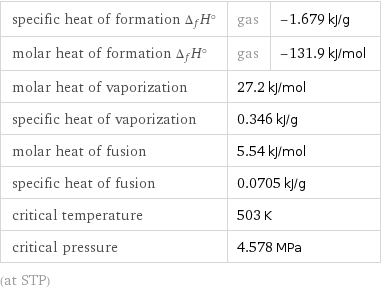
specific heat of formation Δ_fH° | gas | -1.679 kJ/g molar heat of formation Δ_fH° | gas | -131.9 kJ/mol molar heat of vaporization | 27.2 kJ/mol | specific heat of vaporization | 0.346 kJ/g | molar heat of fusion | 5.54 kJ/mol | specific heat of fusion | 0.0705 kJ/g | critical temperature | 503 K | critical pressure | 4.578 MPa | (at STP)
Chemical identifiers
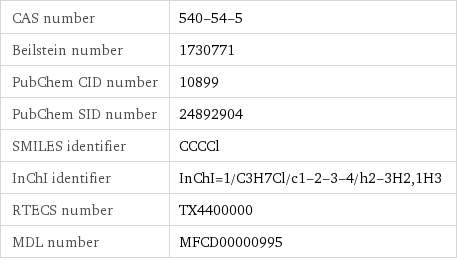
CAS number | 540-54-5 Beilstein number | 1730771 PubChem CID number | 10899 PubChem SID number | 24892904 SMILES identifier | CCCCl InChI identifier | InChI=1/C3H7Cl/c1-2-3-4/h2-3H2, 1H3 RTECS number | TX4400000 MDL number | MFCD00000995
NFPA label

NFPA label
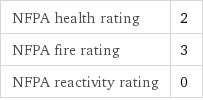
NFPA health rating | 2 NFPA fire rating | 3 NFPA reactivity rating | 0
Safety properties

flash point | -31.67 °C autoignition point | 520 °C lower explosive limit | 2.6% (concentration in air) upper explosive limit | 11.1% (concentration in air)

DOT hazard class | 3 DOT numbers | 1278
Toxicity properties

RTECS classes | other